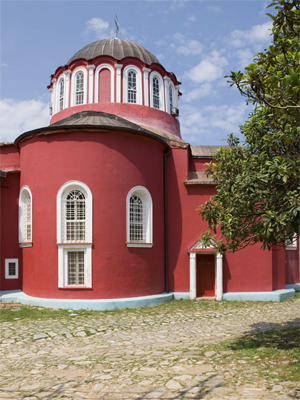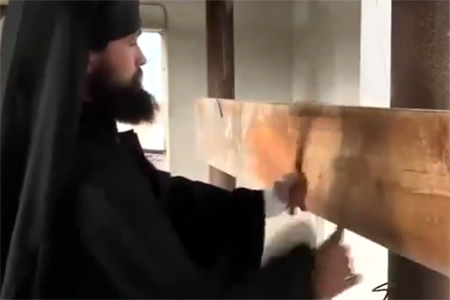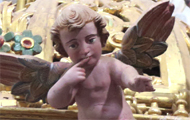| |
 |
 |
 |
| Comment on this report, or find other reports. |
 |
| Our Mystery Worshippers are volunteers who warm church pews for us around the world. If you'd like to become a Mystery Worshipper, start here. |
 |
| Find out how to reproduce this report in your church magazine or website. |
|
|
| 3170: Holy and Great Lavra, Mount Athos |
 |
 |
 |
Mystery Worshipper: Columba's Currach.
The church: Holy and Great Lavra, Mount Athos.
Denomination: Eastern Orthodox, under the jurisdiction of the Ecumenical Patriarch of Constantinople.
The building: The buildings of the Great Lavra are some of the most beautiful and interesting on Mount Athos. Not only is it the oldest monastery there, but it is the only one not to have suffered a major fire. The main church and refectory are set inside a courtyard surrounded by cloisters and a fortified wall. There are also many small chapels and a free-standing bell-tower. These are set among beautiful gardens with many rose bushes, fountains, and even a goldfish pond.
The church: This is where it all began on Mount Athos. The Great Lavra was founded in AD963 by St Athanasius the Athonite, with funding from the Byzantine Emperor Nikephoros II Phokas.
The monks here have alternated between coenobitic (communal) and idiorrhythmic (isolationist) monasticism. The former is not unlike the Rule of St Benedict, which is in fact a Western derivation of it. The latter, derived from the practice of the early Desert Fathers, involves each monk living as a hermit (albeit with widely varying levels of comfort) and only coming together for the liturgies on Sundays and major feasts. Since 1980, the Great Lavra has been coenobitic.
The neighbourhood: The Great Lavra is located near the southern tip of the Mount Athos peninsula. It faces the sea on one end, but on two of the landward sides faces the "desert" of Mount Athos, a rugged area without any passable roads, where some monks still live as hermits in conditions not wildly different from those of the Desert Fathers and other ascetics of late antiquity.
The cast: It was led by two monks, but I didn't catch their names.
The date & time: 12 May 2017, 5.00pm (or so we had been told – it was actually nearly 5.30 by the time it started).
What was the name of the service?
Vespers.
How full was the building?
Not terribly. There can't have been more than 10 monks and 25 pilgrims there, even though I knew several more were staying on site.
Did anyone welcome you personally?
I had the following conversation with a monk:
"Where are you from?"
"The United Kingdom." "You are Orthodox?" "'No."
"You must stay here always" (pointing to the back of the narthex) "and when the Orthodox come to venerate the Holy Relics, you do not come!"
This was said without any malice on his part, and I didn't mind. It was reassuring to know where I stood. Literally.
Was your pew comfortable?
The misericord at the back of the narthex – safely separated from the right-believing faithful – was perfectly comfortable.
How would you describe the pre-service
atmosphere?
There was a lot of expectation. Before the service began, an elderly monk was talking to anyone who would listen about the places he'd been to as a merchant sailor before becoming a monk. More disturbingly, he then began to talk about how the evil of the world was due to "the secret government, the government behind the governments, which is a force of great darkness." I couldn't tell to whom he was referring, whether it was a fairly standard (if eccentrically phrased) critique of the political influence of economic elites in late capitalism, a reference to the Illuminati, or – worst case scenario – something from the Protocols of the Elders of Zion. In any case, he seemed hopeful that Donald Trump was going to sort it all out.
What were the exact opening words of the
service?
I'm sorry, I didn't catch them. I tried really hard, but they were chanted incomprehensibly by an aged monk who appeared to be both asthmatic and tone-deaf, and who was also facing away from where I was standing.
What books did the congregation use during the
service?
None.
What musical instruments were played?
Only bells and the semantron (a wooden beam struck with a mallet).

Did anything distract you?
The frescos, painted in the 16th century by the famous iconographer Theophanes the Cretan, were very fine indeed.
I also spent some time counting the ostrich eggs hung from the ceiling. This is one of the stranger aspects of Athonite church decoration. Even Patrick Leigh Fermor, the World War II soldier who had fought in Crete and Greece and wrote several books describing his adventures, was at a loss to explain this (most atypically for him). The best explanations I've heard are that it's either a survival of a pagan good-luck custom or else a somewhat esoteric symbol of the Virgin Birth (because ostriches do not tend their eggs, although in the Bible this is considered a symbol of cruelty rather than parthenogenesis). The largest number of ostrich eggs I've counted in a Greek church was 21. I think there were slightly fewer here.
Was the worship stiff-upper-lip, happy clappy, or
what?
Rather indifferently celebrated Orthodox liturgy, without the musical sophistication I'd seen the day previously at Simonopetra.
Exactly how long was the sermon?
There was none.
Which part of the service was like being in
heaven?
The building certainly managed to convey a sense of heaven on earth, as Orthodox churches are meant to do.
And which part was like being in... er... the other place?
Athos is exclusive. I had known that before going there. It's no secret that women are totally banned, and that there is a sharp distinction drawn between monks and non-monastic laymen, to say nothing of the distinction between Orthodox and non-Orthodox.
My Anglophone pilgrim's guide coyly states that "Athos has never been at the forefront of ecumenical dialogue." It would be more accurate to state that Athos has historically been, and to a large extent remains, absolutely opposed to any cooperation between Eastern Orthodox churches and other Christian bodies. I couldn't help but contrast my reception here with the welcome I've always received in Orthodox parishes in England, and indeed in all Roman Catholic churches (secular or monastic) everywhere in the world. I wondered if all of those who become monks on Mount Athos are really motivated by a desire to be nearer to God, rather than play-acting at recreating a neo-Byzantine Empire where the sexes are firmly separated and heretics are kept firmly at bay. Even if that's too harsh (and it probably is), it seemed an awfully poor advertisement for Eastern Orthodoxy.
What happened when you hung around after the service looking lost?
We all processed into the refectory. On the way, though, there was another chance to highlight my outsider status. The monks were distributing some sort of blessed cornmeal mush. I wasn't sure if I was allowed to consume this, so I said – in my best Demotic Greek – that I was not Orthodox. One of the monks actually pushed me away! I know that Greeks tend to be more expressive than Englishmen, and with less regard for personal space, but this seemed a bit much to me.
How would you describe the after-service
coffee?
We had a full meal. It was a Friday, so the food was totally vegan, consisting of bread, some kind of porridge, and olives.
The refectory is gloriously covered in frescos, which – like those in the church – are by Theophanes the Cretan. These presented a slightly odd contrast to the UV insect-zapping lights suspended from the ceiling. A monk read a passage from one of the Church Fathers.
How would you feel about making this church your regular (where 10 = ecstatic, 0 = terminal)?
0 – Once again, it is not really possible for a layman, particularly if not Orthodox, to make this his regular church. If it were possible, though, it would be very far from my first choice!
Did the service make you feel glad to be a
Christian?
I'm afraid it mostly made me glad not to be Eastern Orthodox.
What one thing will you remember about all this in seven days' time?
The behaviour of monks "not at the forefront of ecumenical dialogue." |
|
|
 |
 |
 |
| We rely on voluntary donations to stay online. If you're a regular visitor to Ship of Fools, please consider supporting us. |
 |
 |
 |
| The Mystery Pilgrim |
 |
| One of our most seasoned reporters makes the Camino pilgrimage to Santiago de Compostela in Spain. Read here. |
 |
 |
 |
| London churches |
 |
| Read reports from 70 London churches, visited by a small army of Mystery Worshippers on one single Sunday. Read here. |
| |
|
|
|
|


